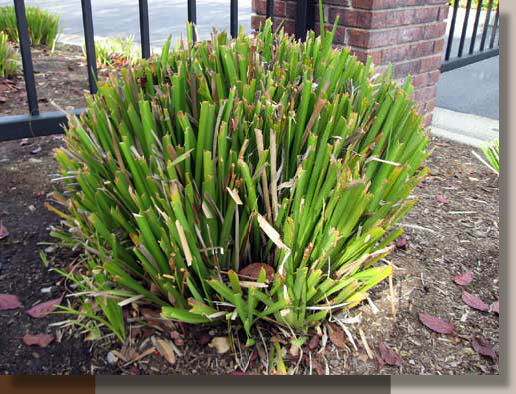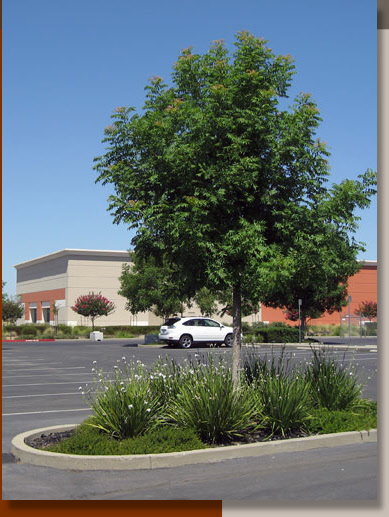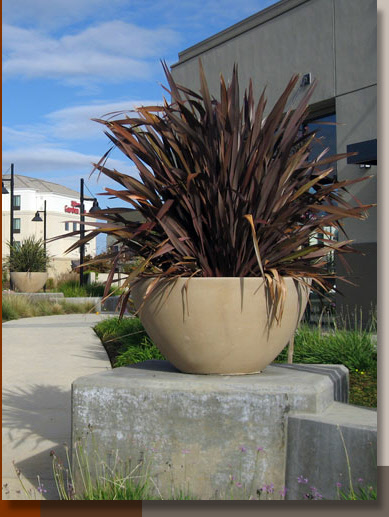


Garth Ruffner Landscape Architect


Tough flowering perennials require about the same level of care as neighboring woody plants. Some additional effort can enhance their impact.


Perennial Care Recommendations
Plucking off spent flowers (dead heading) encourages a longer and more prolific blooming season. In most commercially maintained landscapes, dead heading is too time consuming, but cutting off spent flower stalks (at the base) enhances many perennials (with the exception of Fortnight Lilies).
Most perennials lose vigor as they age. Dividing the root mass (rhizomes, tubers, etc.) of excessively mature plants during the Winter can turn one struggling clump of ratty foliage into multiple healthy plants, allowing bare soil areas to be planted without purchasing nursery stock.
Society Garlic (Tulbaghia violacea) is extremely durable and blooms for about 8 months. The plants send up too many flower stems to prune them individually, so shearing them at the edge of the foliage mass is effective and promotes reblooming when the stalks dry up. Minor shearing damage to the tips of the foliage does not seem to harm the plants.
Daylilies (Hemerocallis hybrids) provide a wide variety of flower colors, forms and blooming seasons. Mixing multiple hybrids extends the bloom season and showcases their diversity.
Most of the hybrids specified by this Office have evergreen foliage which should not be cut back unless damaged foliage is widespread. Dead foliage usually collects around the bases of the plants and can be pulled away by hand.
The flower stalks should be cut off within the foliage clump when the plant finishes blooming. At 3-5 years of age, Daylilies can be divided and used to revegetate bare areas.
New Zealand Flax (Phormium tenax) is generally much larger than the other perennials addressed on this page and is grown primarily for its foliage. Damaged leaves should be cut off at the base of the clump rather than cutting off damaged tips. The plants should never be sheared into “decorative” shapes. When significant dead foliage builds up, the plant should be cut off 3-4 inches above finish grade in late Winter.

Fortnight Lilies (Dietes bicolor & vegeta) are reliable bloomers with evergreen foliage. Each flower stem will produce for a year or more and ought to be left in place until it has clearly dried up. The dead stems should be cut off at their bases.
Some damaged leaves are nearly always present on Fortnight Lilies. Pruning away dead foliage at the base of the clump gives the plant a tidier look, but it is not necessary.
At about 25°, most or all the leaves will turn brown and not recover. When frost danger ends, the plants should be cut flat to a height of 3 inches and allowed to regrow.

Shearing strap leaved perennials into balls (as shown at right) does not rejuvenate them. While new growth will struggle through the mutilated foliage, the plant will not recover for months.
Dead or damaged foliage should be cut off at the base of the clump. If the quantity of poor quality leaves is excessive, the plant should be cut flat to a height of 2 to 3 inches in late Winter.

Mutilated Fortnight Lily

Lily-of-the-Nile (Agapanthus orientalis) is probably the most widely used perennial in Central California. Flower stalks should be cut off within the foliage clump after the plants finish blooming. Leaves are damaged by frost and become brown goo in severe freezes. Damaged or dead foliage can be cut off when there is no further danger of frost. The plants will recover quickly.

New Zealand Flax at Laguna Pointe
Vista Park Office/Warehouses

